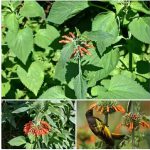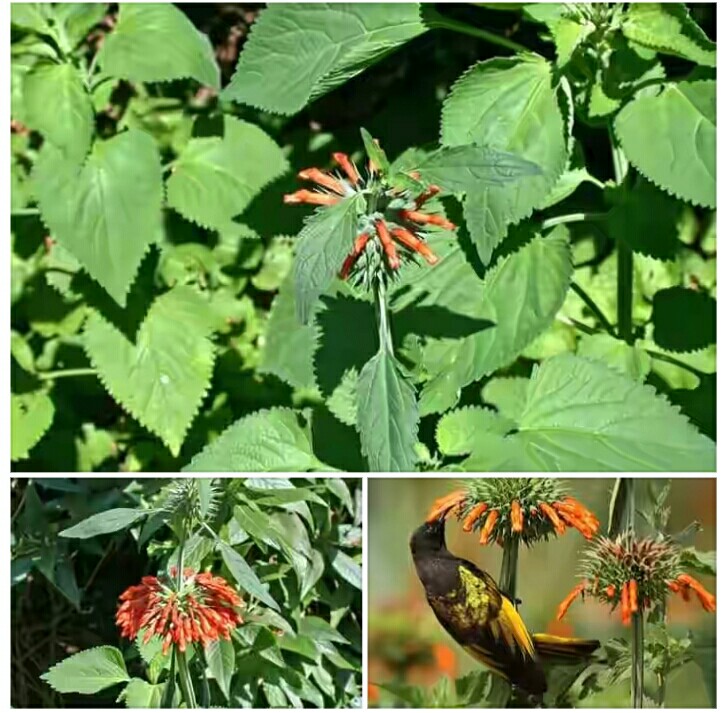Leonotis nepetifolia; common names: Leonotis africana (botanical name) or Lion’s ear, Lion’s tail, Christmas candlestick, Wild dagga, Johnny Collins, Pincushion devil, Bird honey, Bald head (English) or Jan barawo, Kan mutum, Tutar ƴan sarki, Cika saura (Hausa): A tropical ornamental shrub with many medicinal values
DISTRIBUTION AND OCCURRENCE: Leonotis nepetifolia is a shrub belonging to the Lamiaceae (mint) family, which comprises of about 3,200 species in 200 genera. The stems are relatively robust, sparsely branched, and sparsely covered in small whitish hairs (i.e. they are puberulent). These stems are four-angled (i.e. quadrangular) and usually have a distinct groove running lengthwise (i.e. longitudinally) down the centre of each side. The leaves (4.5-20 cm long and 2-15 cm wide) are oppositely arranged along the stems and borne on stalks (i.e. petioles) 2-10 mm long. The lower leaves, which are somewhat egg-shaped in outline (i.e. oblong-ovate or ovate), are larger and broader than those towards the top of the plant.
All leaves have distinctly toothed (i.e. crenate or serrate) margins, pointed tips (i.e. acute apices), and are sparsely hairy (i.e puberulent). The flowers are borne in dense rounded (i.e. spherical) clusters (5-6 cm across) towards the tops of the stems (usually 2-4 clusters per stem).
Each of these clusters is arranged directly on the main stem, just above a pair of leaves (i.e. sessile axillary clusters). The individual flowers (20-40 mm long) are orange or reddish-orange in colour and tubular in shape with two main lobes (i.e. they are two-lipped). The lower of these lobes is further divided near its tip, while the upper lobe is somewhat arched or curved and densely hairy. These flowers are surrounded by a green tube (i.e. calyx tube) 12-15 mm long and each flower also has two elongated (i.e. lanceolate) and pointed green bracts associated with it.
The flower clusters form a hard and somewhat spiky ball when mature, and consist mainly of the persistent calyx tubes (which enlarge to 15-25 mm long in fruit). Each individual fruit is a four-lobed ‘capsule’ (i.e. schizocarp) that separates into four ‘seeds’ (i.e. nutlets) when mature. These ‘seeds’ are dark brown or dull black in colour, and either somewhat egg-shaped (i.e. oblong-ovoid) or triangular in shape (2.5-4.3 mm long and 1-1.9 mm wide). The flowers produce nectar which attracts birds, bees and butterflies. The fruits are 2 mm nutlets. All the plant parts have a strong mint smell similar to other Lamiaceae species.
The plant can be found in East Tropical Africa: Kenya, Tanzania and Uganda; Northeast Tropical Africa: Chad, Ethiopia and Sudan; South Tropical Africa: Angola, Malawi, Mozambique, Zambia and Zimbabwe; Southern Africa: Botswana, Namibia, Natal, Swaziland and Transvaal; West Tropical Africa: Benin, Burkina, Ghana, Guinea, Guinea-Bissau, Ivory Coast, Liberia, Mali, Niger, Nigeria, Senegal, Sierra Leone, The Gambia and Togo; West-Central Tropical Africa: Burundi, Cameroon, Central African Republic, Gabon, Gulf of Guinea Is, Rwanda and Zaire; Western Indian Ocean: Madagascar and Mauritius; Asia-Tropical: Indian Subcontinent, Nepal and Sri Lanka.
USES OF WILD DAGGA
The flowers are cooked with green, leafy vegetables and consumed as a delicious snack. The nectar is sucked or licked from the base of the flowers. It tastes sweet and is usually eaten in small amounts as a snack. It is usually much liked by children. There is a record from Peninsular Malaysia of Leonotis nepetifolia leaves being used externally to treat wounds. In India and Thailand, the ash of flower buds is applied externally to burns, scalds, itch and ringworm.
In Africa Leonotis nepetifolia is more commonly used in traditional medicine. The leaves are applied externally to wounds, sores, ulcers, piles, swellings and skin infections. A decoction of whole plants is used to steam the head to relieve catarrh, fever and headache. The same decoction is used in a bath to treat rheumatism, sciatica, neuritis and rickets, and it is taken internally as tonic, purge and taeniafuge (against tapeworms) and to treat fever, gastrointestinal troubles and dysmenorrhoea.
The plants are also used to expel vermin from stored grain. In tropical America medicinal applications are also numerous; decoctions of leaves, roots and inflorescences are used as a febrifuge, diuretic, stomachic, vermifuge and tonic, and against asthma and skin diseases.
Hottentots were particularly fond of smoking it instead of tobacco and used a decoction of the leaf as a strong purgative and as an emmenagogue. Early colonialists employed it in the treatment of leprosy. The leaf tea has a hypnotic effect, is diuretic and relieves headache. The leaf and stem decoction or inhalations have been used internally for cough, common cold, influenza, bronchitis, wound healing and asthma. The fresh stem juice is an infusion drunk for ‘blood impurity’.
The infusions made from flowers and seeds, leaves or stems are widely used as tonics for tuberculosis, jaundice, muscular cramps, high blood pressure, diabetes, viral hepatitis, dysentery, and diarrhoea. Tea made from the whole plant is used for arthritis, piles, bladder and kidney disorder, obesity, cancer and rheumatism. The leaves and stems decoction are applied topically as a treatment for eczema, skin infections and itchiness. The leaves, roots and bark are widely used as an emetic for snakebites, bee and scorpion stings.
In Central Africa, a decoction of the plant is used to treat elephantiasis. The Wild dagga smoke has marijuana-like effects with pungent odour and is occasionally mixed with flowers and fruits. In ethnoveterinary the roots and leaves water drink is used in poultry, against cattle gall sickness and eye inflammation. Generally, the plant is a general tonic, having reputed dermatological, antihypertensive, anti- inflammatory as well as pain and wound healing properties.
On the island of Trinidad the leaves are brewed as a tea for fever, coughs, womb prolapse and malaria. Because it contains compounds that produce sedative effects, it is utilized as a sedative in alternative medicine.
This species is also known for its antispasmodic effects and appears to inhibit acetylcholine and histamine which is why it is considered natural anti-histamine and can be used to alleviate allergy symptoms. Antispasmodic is a term that refers to herbs, substances, drugs, compounds, or medicines that suppress muscle spasms. Wild dagga is also much respected in the treatment of animals.
The Tswana, Zulu and Xhosa make a strong brew of leaves, flowers and stems to use as an enema in sheep, goats and cattle, as well as humans. This brew is given to animals with respiratory problems and applied as a lotion to sores on stock and dogs, and as a wash for wounds, scratches, bites and stings. The Zulu people use the root for snakebite and they sprinkle a concoction of the plant around their houses to keep snakes away. The Zulu and Xhosa make a strong brew of the leaves and use as a poultice for snakebites. They also use a tincture of the root bark internally for snake bite.

Overall, having analyzed the scientific literature, it can be concluded that the plant possesses plant diverse activities, such as anticonvulsant, antinociceptive (pain-killing), anti-inflammatory, antidiabetic, antibacterial, anti-oxidant, anthelmintic activities and hypoglycemic properties, which justifies the herb use in the management and control of pain, arthritic, diabetes, dermatological, hypertension, anti-inflammatory and wound healing properties. These activities can be attributed to the presence of monoterpenoids and sesquiterpenoids in the leaves and sepals.
FOR FURTHER READING SEE:
Iwarsson, M and Y. Harvey. 2003. Monograph of the Genus Leonotis (Pers.) R. Br. Kew Bull. 58: 597-645.
These are the thoughts and intellectual property of:
Sa’eed Halilu Bawa
Senior Lecturer (Associate Professor) at University of the West Indies, St. Augustine Campus, Trinidad.
Studied Food and Nutrition Sciences, Dietetics at Kaduna Polytechnic, Nigeria; Warsaw University of Life Sciences, Poland.
























